How review volumes and recency impact purchase behavior, based on insights from more than 9,000 consumers and analysis of activity across 1.5MM+ ecommerce product pages on 1,200+ brand and retailer sites.
Survey at a Glance:
The Power of Review Volume & Recency explores the importance to consumers of product review volumes and review recency when shopping online. Key findings include:
- 97% of consumers consider review recency to be at least somewhat important when considering a purchase.
- 64% of consumers say they’re more likely to buy a product with fewer, more recent reviews than if it has a higher volume of reviews published three or more months ago. This number is even higher – 69% – among Boomers.
- 86% of shoppers feel that review recency is more important when considering a product or brand they haven’t purchased before.
- Ideally, nearly half (44%) of consumers want to be able to find reviews written within the past month.
- Just over a third (38%) will not purchase a product if the only reviews available were published three months or more ago.
- 62% will not purchase a product if the only reviews available were published a year or more ago.
- 79% of consumers consider the volume of reviews “always” or “regularly” when reading this content.
- In an ideal world, 23% say products should have more than 500 reviews. However, they’re willing to settle for fewer. Nearly half (45%) say a product must have a minimum of 1-25 reviews for them to feel comfortable purchasing it.
- Consumers expect a lot of reviews, but typically, they read far fewer. The majority of shoppers – 69% – read between one and 25 reviews when considering a product.
- 80% of consumers are less likely to buy a product if it has no reviews. This number is even higher – 92% – among Gen Z shoppers.
- 64% of consumers are more likely to purchase a product that has more than 1,000 reviews than one that has 100 reviews (assuming the average star rating is the same). Significantly more – 80% – of Gen Z’ers say this is the case.
- Over half (54%) of consumers are more likely to purchase a product with 10,000 or more reviews than one with 1,000 reviews. The number is even higher – 73% – among Gen Z shoppers.
- There’s a 296.2% lift in conversion among shoppers who are exposed to 5,000 or more reviews, when compared to those exposed to no reviews.
- Visitors exposed to 5,000+ reviews convert at a rate that’s 122.1% higher than those exposed to between one and 100 reviews.
- A high volume of reviews impact conversion lift for products across categories, including:
- Consumer packaged goods (CPG)
- Health and beauty
- Baby
- Automotive and motorsports
- Consumer electronics and appliances
- Apparel and accessories
- Toys
- Home and garden, machinery and tools, and furniture
Contents
Introduction
Reviews Have Never Been More Important
Consumers weigh a variety of factors when making purchase decisions. But our own recent research found that reviews have become the most important factor, ranking above other important elements including price and recommendations from family and friends.
In fact, 99.9% of consumers read reviews when shopping online at least sometimes. And 57% do so when shopping in-store.
By now, the vast majority of brands and retailers have heard this message loud and clear and have started to collect ratings and reviews. But are their efforts enough to satisfy shopper expectations and drive maximum ROI?
The Presence of Reviews Alone isn’t Enough to Satisfy Shoppers
Consumers seek out reviews when they’re shopping for just about anything online and – increasingly – offline. But simply having reviews for a given product isn’t enough to convince shoppers to buy it.
Instead, our previous research has found that consumers consider many components when reading reviews; there are two that are particularly important.
The first factor is review recency – in other words, how long ago reviews were published for a given product. The second is review volume, or the number of reviews available for a given product.
We wanted to explore just how important both these factors are for consumers.
Research Methodology
It is based on survey responses from 9,012 consumers across the United States and analysis of consumer activity across more than 1.5MM online product pages from more than 1,200 retail and brand sites over a six month period.
The following report draws on insights from two data sources:
- A survey of 9,012 consumers in the U.S. fielded in November 2021. The results are drawn from a panel of consumers who have opted into discounts and incentives from brands and retailers.
- Shopping activity on more than 1.5MM online product pages across more than 1,200 brand and retailer sites between May 1st, 2021 and November 4th, 2021.
While the first part focuses on consumer expectations, preferences and habits – according to consumers themselves, part two shares insights from our analysis of the impact of review quantity on conversion.
By understanding what consumers expect in terms of review quantity and recency – and how these factors impact conversion – brands and retailers are better equipped to meet the needs of shoppers and drive bottom line results.
The Value of Review Recency & Volume, According to Consumers
By now, it’s well understood that the majority of consumers read reviews. Our previous research found that shoppers weigh many factors when reading reviews, including the quantity of reviews for a given product, as well as how recently those reviews were published.
We wanted to further understand exactly why review recency and quantity matters to consumers, when it matters most, and their specific expectations.
Survey Demographics Breakdown
Generations
(1997-present)

(1981-1996)

(1965-1980)

(1946-1964)

Household Income
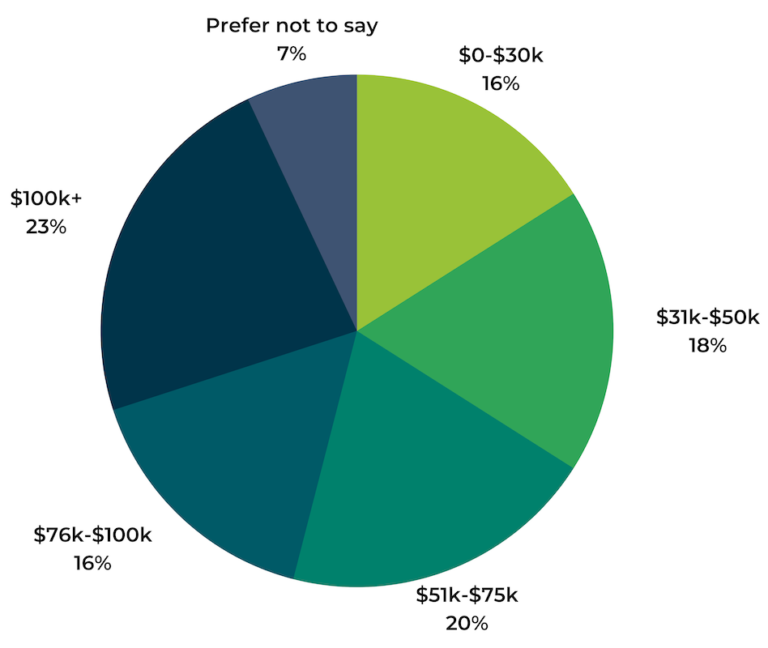
The Importance of Review Recency
A previous survey found that recency is a top factor consumers consider when reading reviews. But just how much value do consumers place on finding fresh review content? And how recent is recent enough?
Review Recency Matters to Consumers
Recency is a MAJOR consideration for consumers.
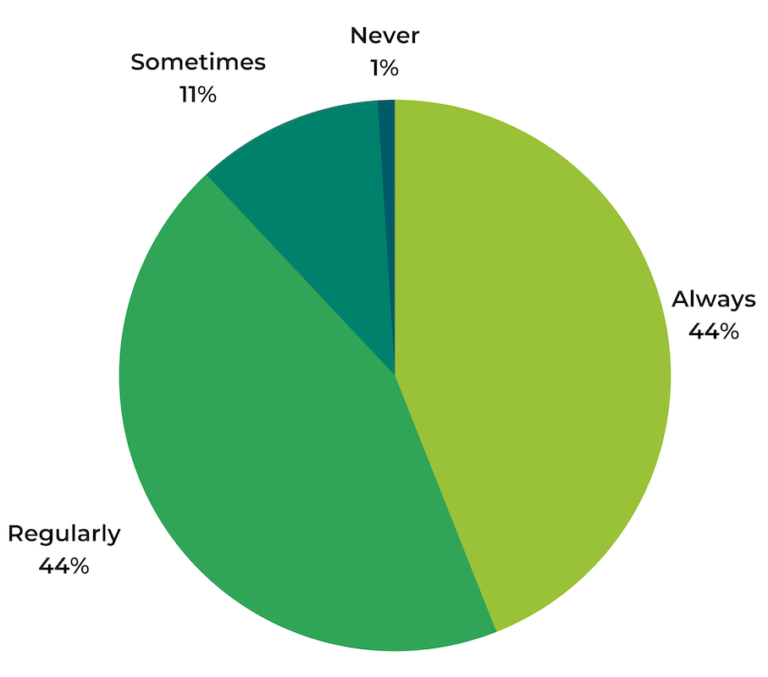
So recency matters. But just how important is review freshness when a shopper is considering a product purchase?
Nearly all – 97% – of consumers consider review recency to be at least somewhat important when weighing a purchase decision:
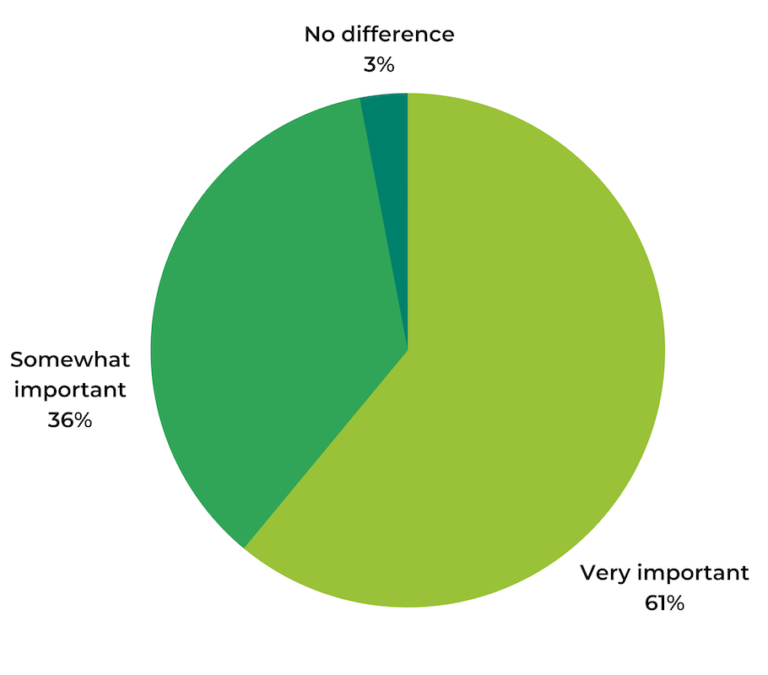
Review Recency Actually Trumps Review Volume
We know that the quantity of reviews for a given product is another factor that consumers consider (and one that we’ll explore in more detail later in this report). When it comes to making purchase decisions, which factor carries more weight: recency or volume?
64% of consumers indicate they’re more likely to buy a product with fewer, more recent reviews than one with a large volume of reviews older than three months.
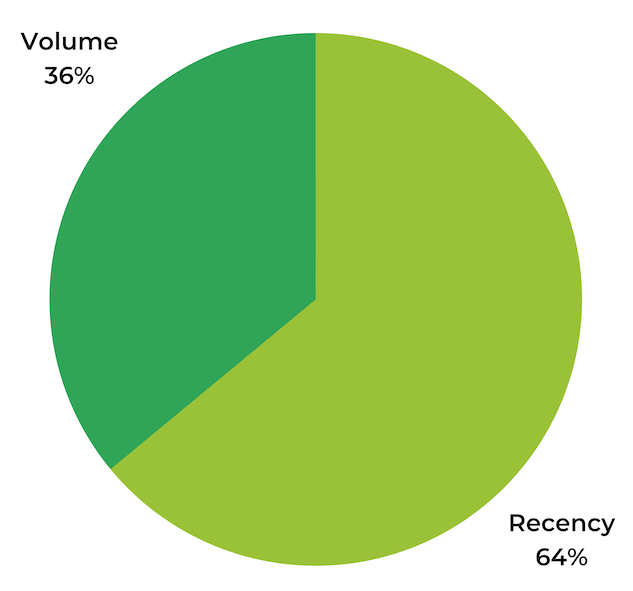
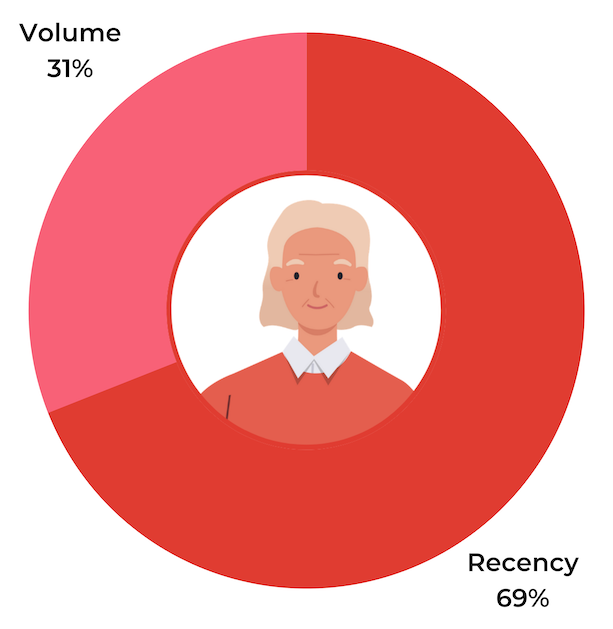
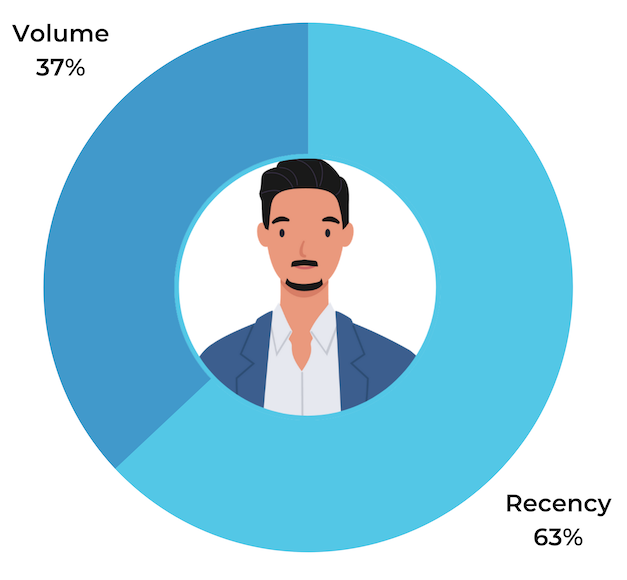
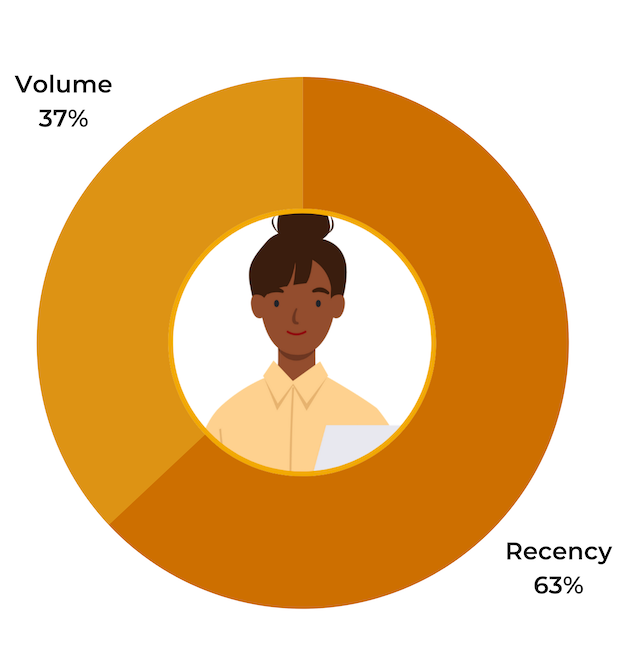
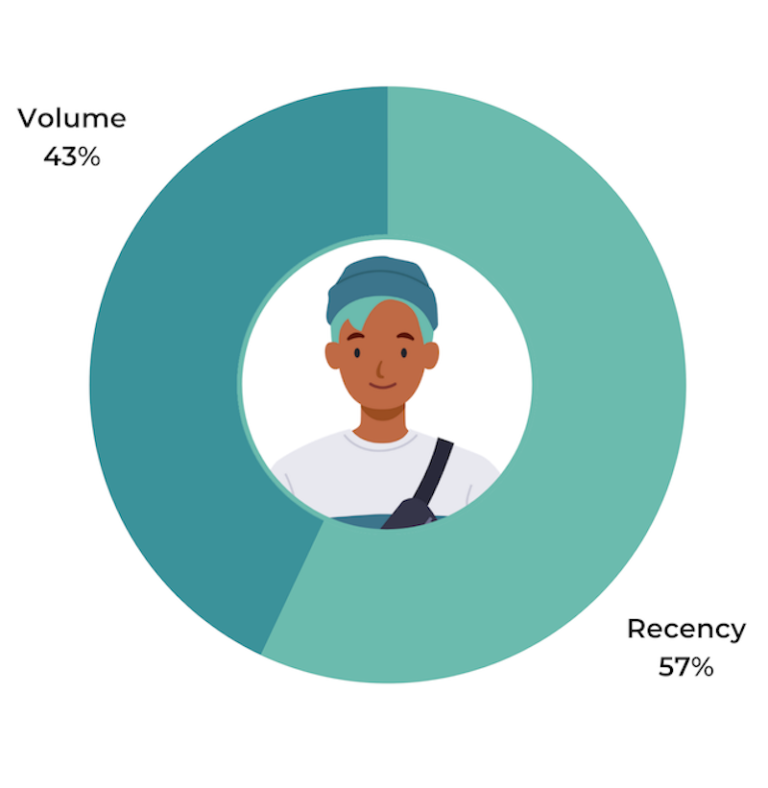
Interestingly, Boomers are the generation most likely to indicate that recent reviews are more important than the quantity of reviews.
Why Recency Matters
We know consumers consider how recently reviews were written. But why do consumers care when a review was published?
Shoppers value recent reviews for a number of important reasons. It’s important that they can easily find fresh reviews for the products they’re considering.
Shoppers Have High Expectations for Recent Reviews
Clearly, consumers care about how recently a review was written. But how recent is recent enough?
In an ideal world, nearly half (44%) want to see review content written within the past month.
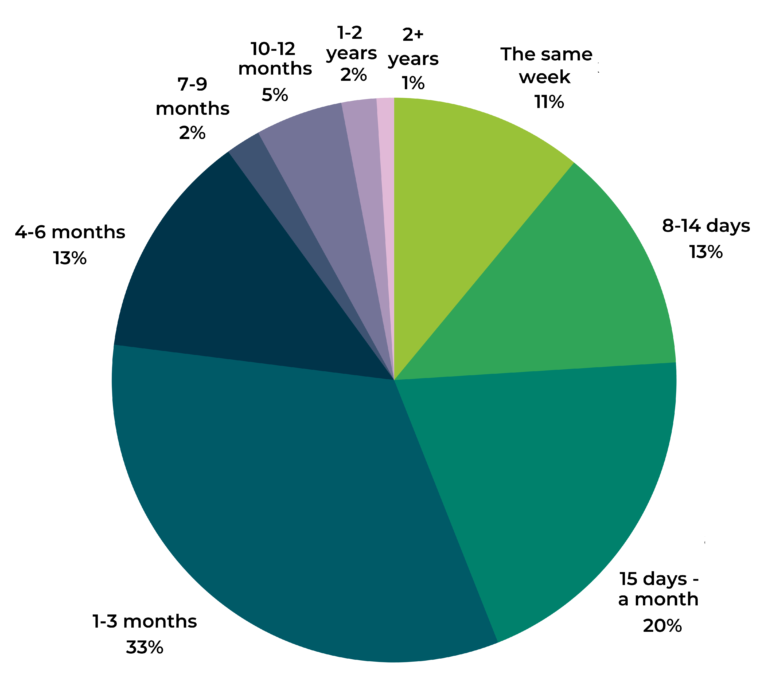
When it comes to the recency of reviews, consumers have high expectations. Brands and retailers must make it a priority to consistently generate a steady stream of reviews so shoppers can always find the fresh content they’ve come to expect.
A Lack of Recent Reviews Can Deter Shoppers
Consumers expect to find recently published reviews for the products they’re considering. If they come up short, they’re likely to pass up a product in favor of one with fresher content.
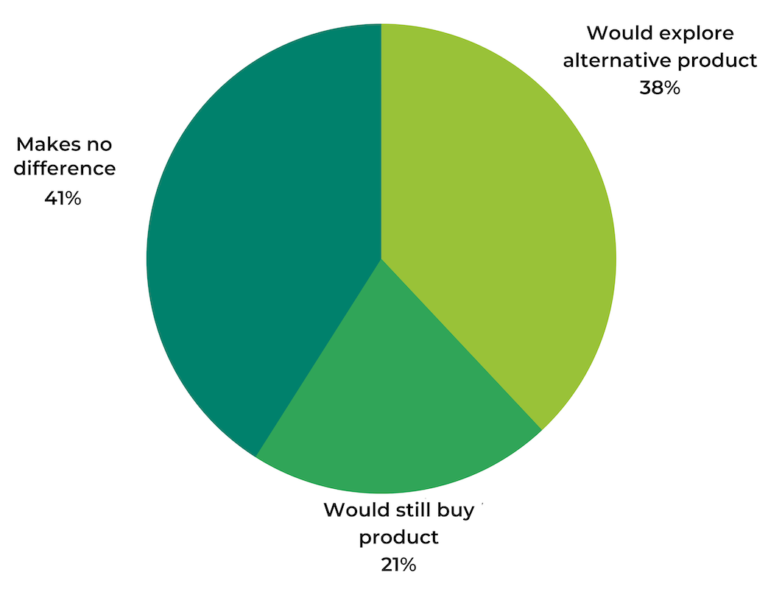
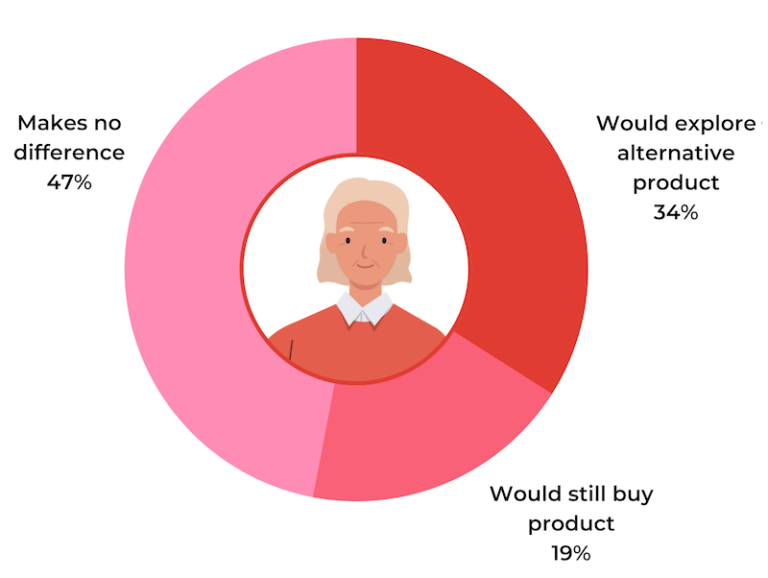
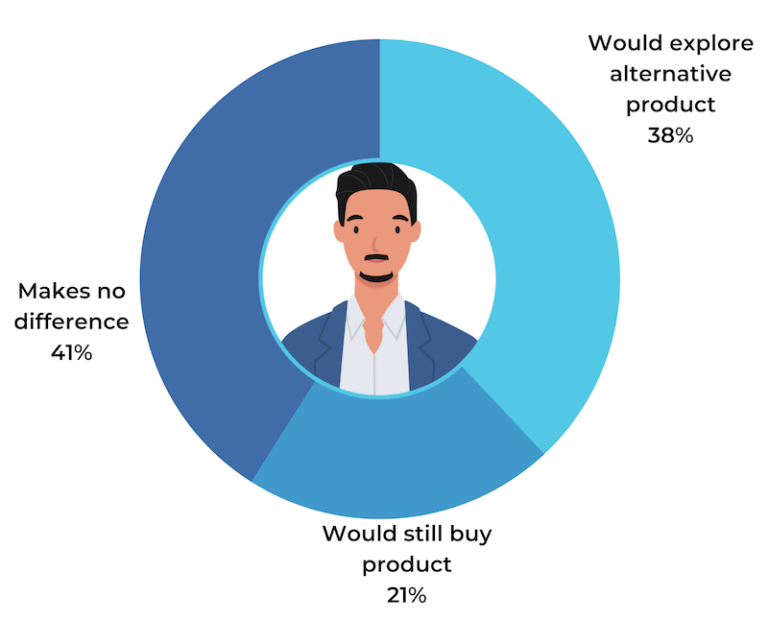
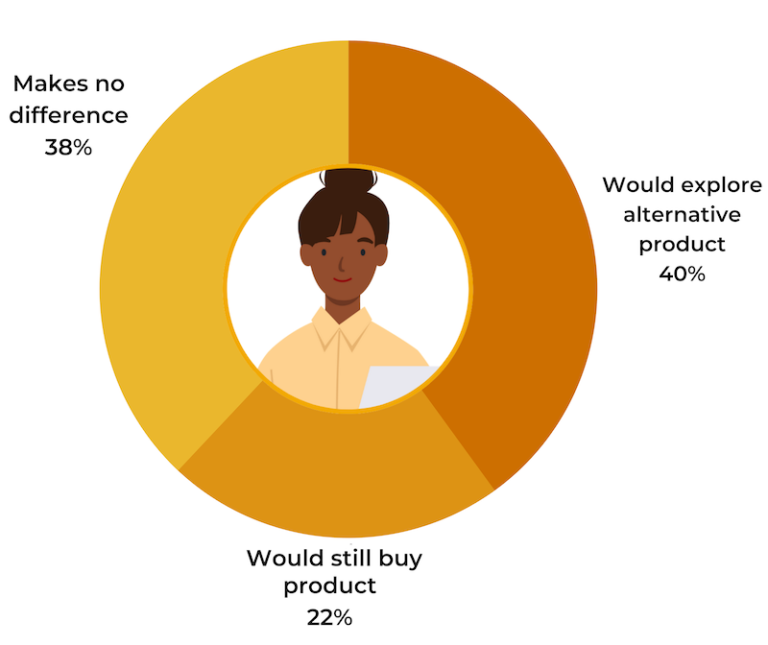
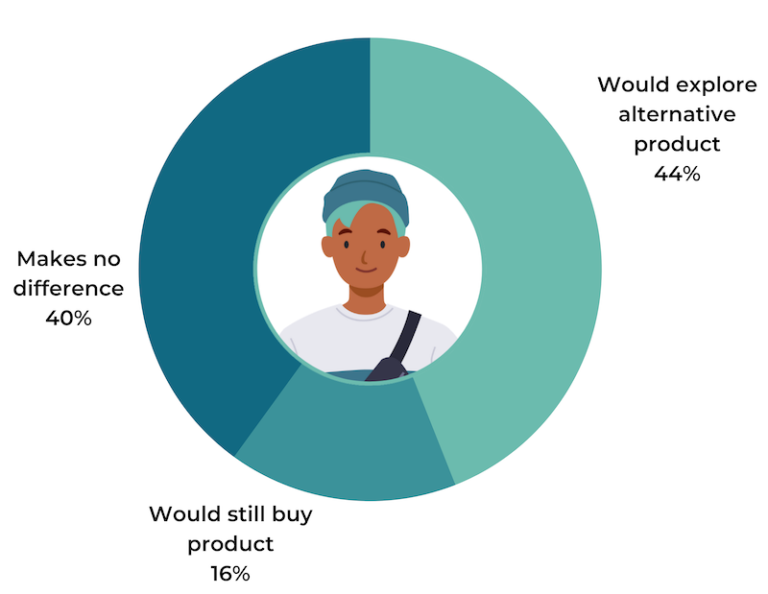
So over a third of those we surveyed (38%) indicate that if all reviews for a product were published three months ago or more, they’d be more likely to purchase a different product from a competitor with more recent reviews. Interestingly, that number is even higher – 44% – among Gen Z shoppers.
The older the reviews for a product, the more likely a consumer is to go with a different product instead.
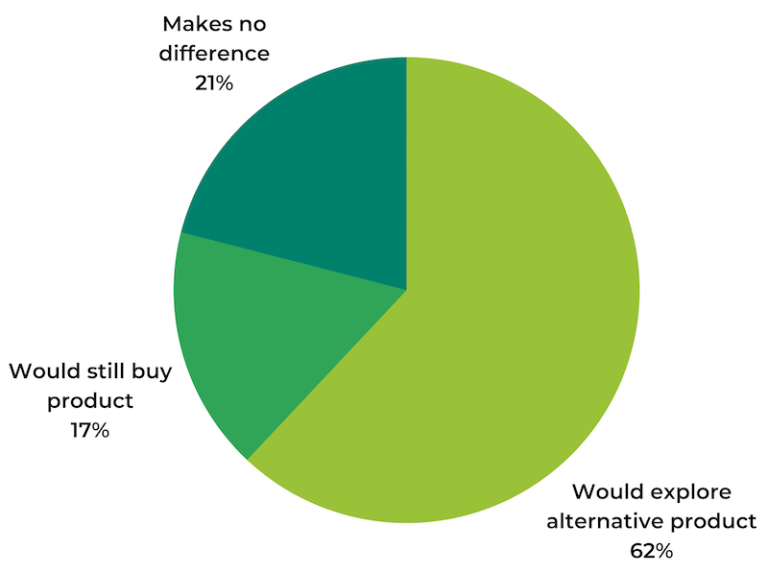
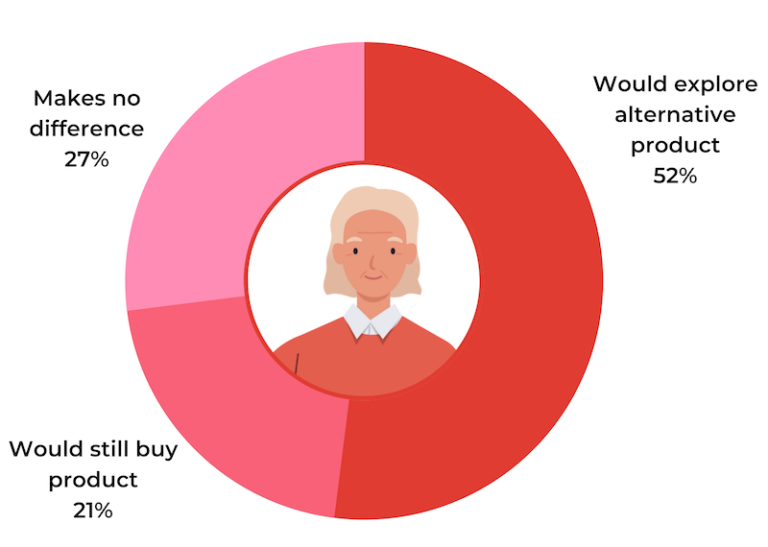
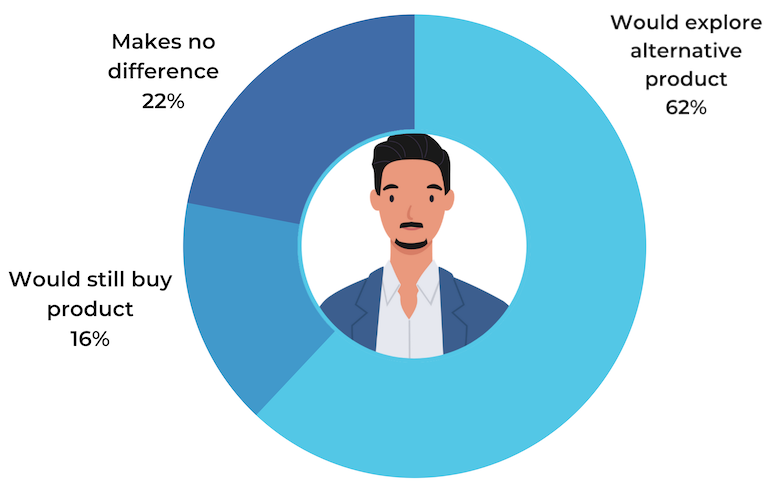
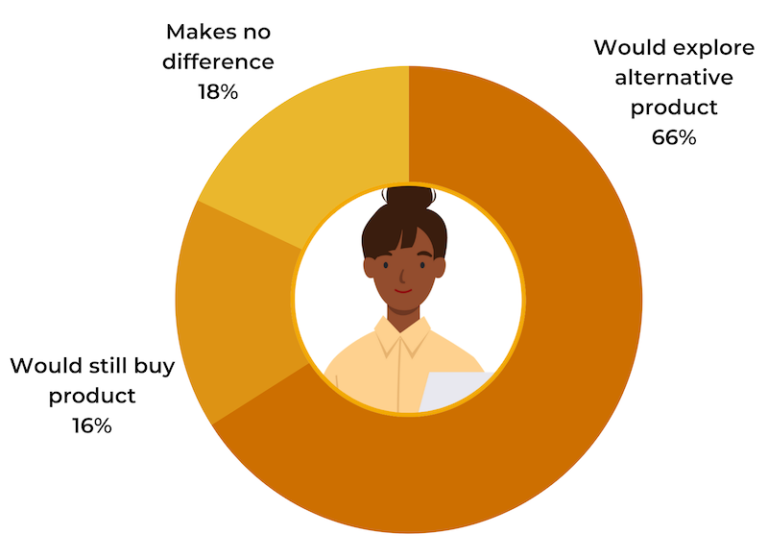
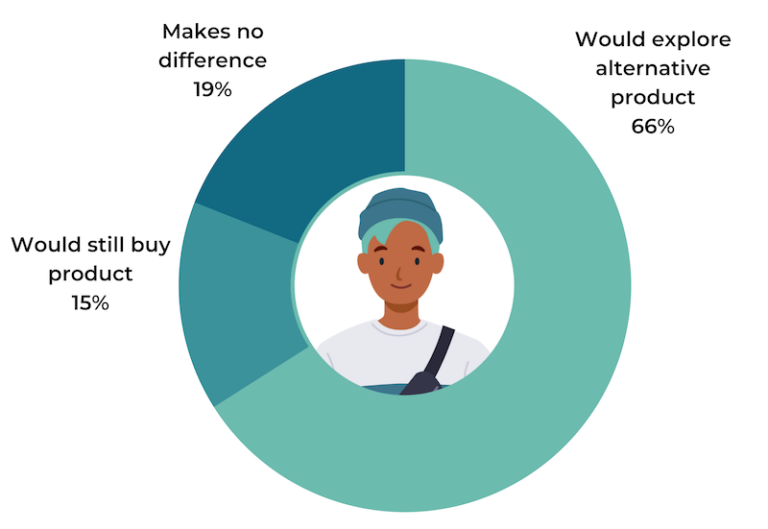
Younger consumers are even more likely to find an alternative product if the one they’re considering only has reviews that were published a year or more ago. 66% of Gen Z’ers would do so, compared to 52% of Boomers.
When Review Recency Matters Most
So, shoppers pay attention to when reviews were written. But are there certain circumstances when recency matters more?
As it turns out, yes. The majority (86%) feel that review recency is even more important when they’re considering a brand or product they haven’t purchased before. That makes sense, as there’s risk involved with purchasing a new or unknown brand or product. Fresh, relevant reviews can help shoppers overcome that risk to make a confident purchase.
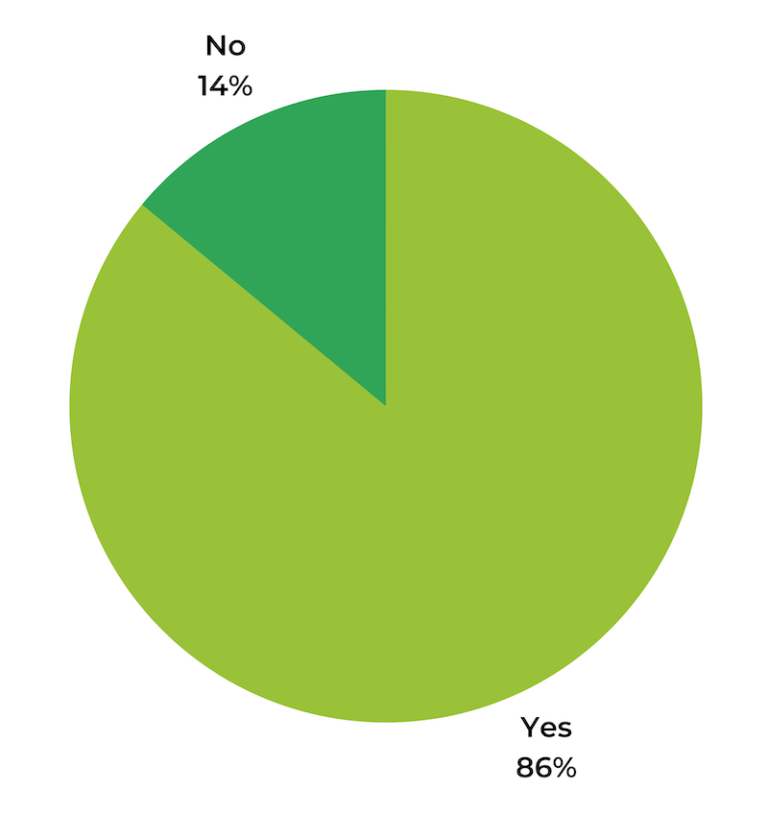
We know from our previous research that consumers read reviews when they’re purchasing products across a wide array of categories. And our most recent survey found that most consumers want to find recent reviews for products they’re considering. That begs the question: does recency matter more for certain product categories?
It’s clear that review recency is important – no matter what type of product a shopper is looking for. In order to attract and convert shoppers, brands and retailers must consistently generate fresh reviews for products of all types. If they don’t, shoppers are likely to look elsewhere.
How Review Volume Impacts Purchase Behavior
Volume is another top factor shoppers consider when reading reviews. In other words, consumers pay attention to the quantity of reviews written about a given product.
How many reviews are enough to satisfy consumers? And how does the presence (or lack) of a high volume of reviews impact purchase behavior?
Most Consumers Consider Volume
For many consumers, the quantity of reviews is top of mind when shopping for a given product. In fact, 99% of consumers consider the volume of reviews – at least to some extent – when shopping online.
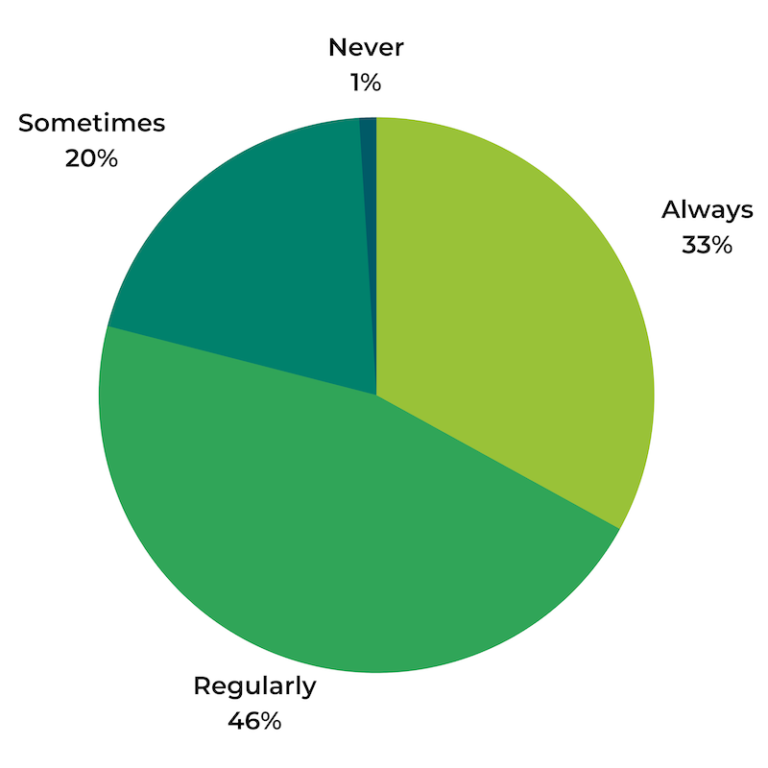
Consumers Want a High Volume of Reviews – But They Actually Read Far Fewer
Consumers pay attention to review quantity. But how many reviews do they typically read? And how many is enough to satisfy them?
Ideally, consumers want to be able to find a high volume of reviews – and many want to find an extremely high volume.
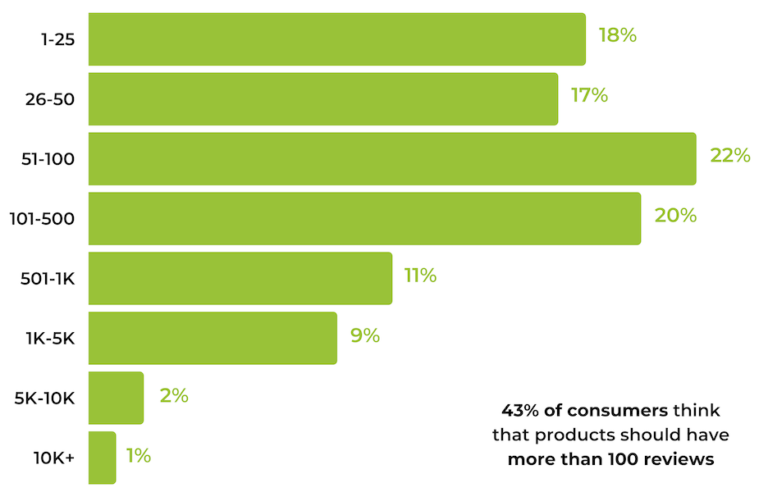
However, despite these high expectations, many consumers are willing to settle for fewer reviews before buying a product.
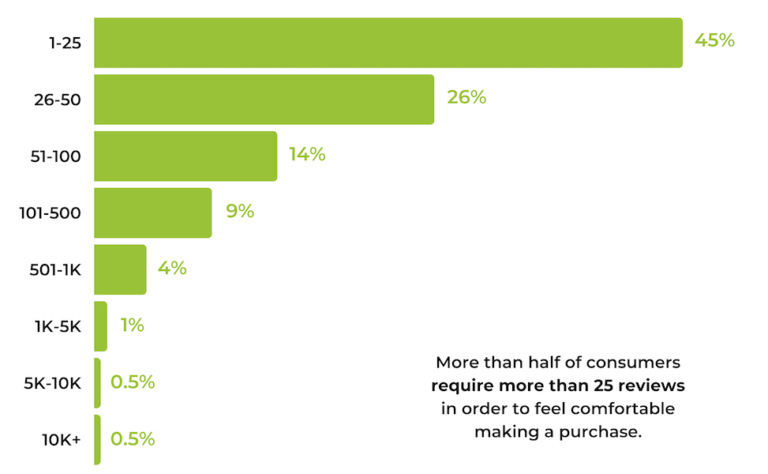
Consumers want to find plenty of reviews for a product they’re considering. But how many reviews do they actually read?
The majority of consumers (69% to be exact) typically read between one and 25 reviews.
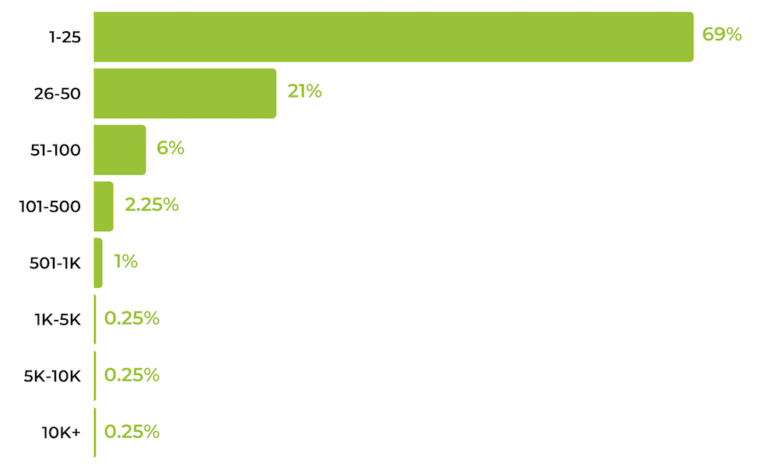
If most consumers read between one and 50 reviews for a given product, then why do they want to find so many more? One critical likely reason: a high volume of reviews ensures a shopper can sort and filter to find reviews that are relevant to their needs and use case. Then, they read the reviews most relevant to them.
Review Volume (or Lack Thereof) Impacts Purchase Likelihood
Consumers expect a high volume of reviews for any given product. But how does the presence (or absence) of a large quantity of reviews impact whether or not they decide to make a purchase?
If there are no ratings or reviews for a given product, 80% of those we surveyed say they are less likely to buy it.
Younger generations are even more likely to steer clear of products without ratings and reviews. 90% of Gen Z shoppers and 86% of Millennials indicate they’d be less likely to purchase a product with no ratings and reviews, compared to 78% of Gen X’ers and 70% of Boomers.
But make no mistake: a significant portion of shoppers across all generations are deterred by a lack of reviews.
If a nonexistent volume of reviews can negatively impact purchase decisions, then can a high volume of reviews positively impact purchase likelihood?
In a word, yes.
Younger consumers are even more likely to be influenced if a product has more than 1,000 reviews.
But what if a product has an extremely high quantity (10,000 or more) reviews? Over half (54%) of consumers would be more likely to purchase it than if it has 1,000 reviews.
And again, younger consumers are more likely to be swayed by this high volume of reviews.
So to sum up: A lack of reviews deters most shoppers. On the other hand, a high volume of reviews increases the likelihood a shopper will purchase the product in question. And the higher the volume, the better. Brands and retailers must ensure they have plenty of reviews for the products in their catalogs.
A High Volume of Reviews Boosts Shopper Confidence When Purchasing New Products
Most shoppers have tried and true products that they purchase time after time. For example, a consumer might purchase the same moisturizer and foundation every time he or she runs out. But there are also instances when consumers consider new (or new to them) brands and products. There’s risk involved with purchasing something new, and reviews help remove that risk.
When considering new products, younger consumers are more likely to place greater value on review volume than their older counterparts. 84% of Gen Z shoppers and 76% of Millennials feel that the number of reviews is especially important when they’re purchasing a new brand or product, compared to 68% of Gen X’ers and 61% of Boomers.
So, reviews are important for products consumers haven’t previously bought before. But just how many reviews are necessary to give a shopper the confidence they need to purchase a new product or brand?
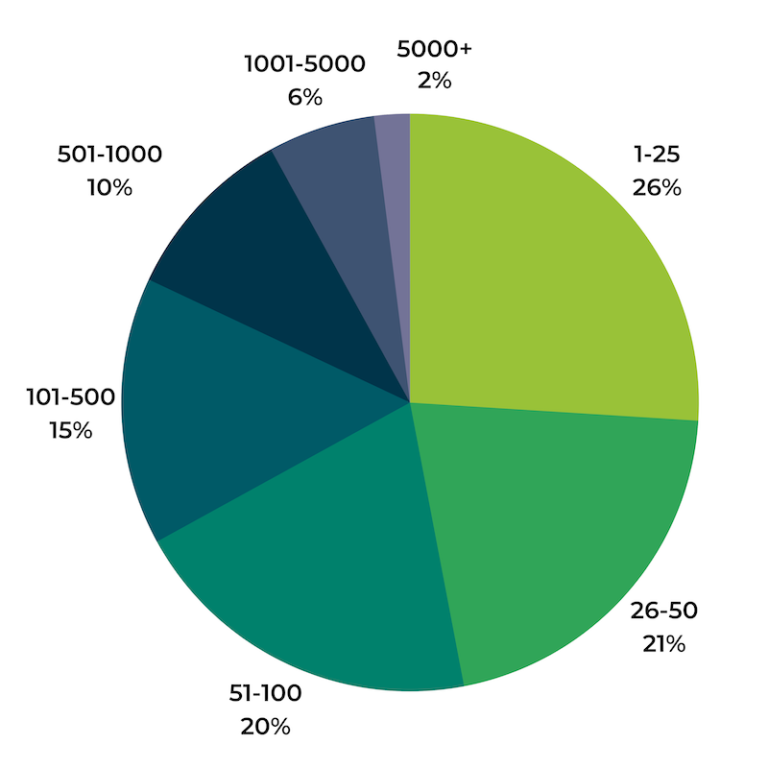
It’s clear consumers value recency when considering new products. As a best practice, be sure to launch new products with plenty of reviews already in place. A great way to do that is through a pre-launch product sampling campaign.
When Review Volume Matters Most
The number of reviews for a given product is a factor consumers weigh when making purchase decisions. But does volume matter more for some products than it does for others?
The fact is, consumers consider review volume when shopping for products across a wide variety of categories.
Review volume is an important factor across all product categories. But does the value consumers place on review quantity vary by product type?
There are two categories for which consumers are most likely to consider review volumes: high price-point or luxury items (73%) and new arrivals (67%). This isn’t surprising, as there’s more at stake when a shopper purchases an expensive or new-to-market product. However, a high volume of reviews can help shoppers overcome the risk and confidently purchase these types of products.
So when it comes to review collection, it makes sense to prioritize high price-point and new products. However, the aim should be to have a large quantity of reviews available for all different types of products.
The Conversion Impact of a High Volume of Reviews
The quantity of reviews available for a given product is something that matters to customers. Our survey of consumers found that 79% regularly or always consider volume when reading product reviews.
But how does the volume of reviews impact one of the metrics that matters most to brands and retailers: conversion?
Earlier this year, we conducted an analysis of consumer activity across more than 1.5MM online product pages from more than 1,200 retail and brand sites. Our key finding? The higher the quantity of reviews, the higher the conversion rate.
This particular analysis explored the impact of displaying a relatively low volume of reviews – up to 100.
However, we know from our most recent survey that while most consumers read between one and 50 reviews for a given product, many expect a much larger volume to be available. If they find a high volume, they say they’re more likely to purchase the product in question.
Remember: 64% of consumers are more likely to purchase a product if it has more than 1,000 reviews than if it has 100 reviews (assuming the average star rating is the same). And 54% say they’re more likely to purchase a product if it has 10,000 reviews than if it had 1,000.
Does what consumers say match up with reality?
To find out, we conducted a deeper analysis. But this time, we expanded the scope to find out how particularly large volumes of reviews – up to 5,000+ – impact conversion rates.
Research Methodology
We analyzed consumer activity during more than 4.5B visits, across more than 1.55MM online product pages from more than 1,200 retail and brand sites during a six month period (May 1, 2021-November 4, 2021). Note: there are simply fewer product pages with the really high review volumes. In cases where data volumes are too low to make meaningful comparisons, we have omitted corresponding volume categories in our analysis below.
In order to accurately assess the impact of high review volumes on shopper behavior, we calculated the visitor conversion rate based on the product page visited with the most reviews during a site visit (counted as all interactions with a specific site in a 24 hour period). This consumer-centric evaluation approach focuses on the shopper and the impact that exposure to reviews has on the likelihood to convert.
How High Review Volumes Affect Shopper Conversion
We know from our previous analysis that there’s a significant lift in conversion when a shopper is exposed to at least one review. And the impact on conversion is most significant when shoppers are exposed to 101 reviews or more.
But what happens when that shopper is exposed to a volume of reviews greater than 101?
The short answer is, they’re even more likely to convert.
When a shopper is exposed to 5,000 or more reviews, there is nearly a 3X lift in conversion rate over no reviews.
Consumers exposed to 5,000 or more reviews convert at a rate that’s nearly three times that of consumers who aren’t exposed to any reviews.
But how does the conversion rate for 5,000+ reviews compare to those exposed to a lower volume of reviews?
There’s a linear relationship between the number of reviews and the lift in conversion. In other words, as the quantity of reviews increases, so too does the lift in conversion.
And the greatest impact is seen when a shopper is exposed to 5,000 or more reviews. Those exposed to 5,000 or more reviews convert at a rate that’s 122.1% higher than those exposed to between one and 100 reviews.
It’s clear that when it comes to reviews, more truly is more.
The Impact of High Review Volume on Various Top Product Categories
We know from our previous research that a large portion of consumers depend on reviews, regardless of product category. And our latest analysis found that review volume positively impacts conversion.
But how does a high volume of reviews impact conversion across specific verticals? Let’s take a closer look.
The Impact of Review Volume on Consumer Packaged Goods (CPG) Conversion
Our survey found that just over a third of consumers (35%) consider review volume when purchasing consumer packaged goods such as snacks, cereal, and pantry items. How does a high volume of reviews impact conversion for these products?
Brands selling CPG see the biggest impact when a consumer is exposed to between 501 and 1,000 reviews.
It is unsurprising that exposure to a product with 501-1000 reviews results in a conversion lift over exposure to 0 reviews, but is it important to achieve such significant review volumes?
In order to determine how much more of an impact large review volume exposure made on shopper conversion rates vs. lower review volumes, we took our analysis one step further and calculated the conversion lift when shoppers are exposed to greater than 100 reviews vs. when they are exposed to 100 reviews or less.
Notably, CPG shoppers exposed to between 501 and 1,000 reviews convert at 2x the rate of those exposed to between one and 100 reviews.
The Impact of Review Volume on Health and Beauty Conversion
The majority of consumers (83%) consider reviews to be helpful when shopping for health and beauty products. And our most recent survey found that review volume is particularly important when consumers are purchasing health and beauty products. Nearly three-quarters (71%) of shoppers consider the quantity of reviews available when shopping for products in this category.
Our conversion analysis found the more the reviews, the better.
Health and beauty brands and retailers must make it a priority to collect a high volume of reviews. If they don’t, they’re leaving money on the table.
The Impact of Review Volume on Baby Product Conversion
A recent survey found that 40% of consumers find reviews to be helpful when shopping for baby products. And a third (34%) factor in review volume when shopping for products in this category. It’s worth mentioning that these numbers are lower than other categories, likely due to the fact that baby products are only purchased by a specific group of consumers.
How does review quantity impact conversion for baby products?
Well, there’s a 286.8% lift in conversion among shoppers exposed to the holy grail of 501-1,000 reviews, compared to those exposed to 100 or fewer.
The Impact of Review Volume on Automotive and Motorsports Conversion
When consumers are shopping for automotive and motorsports products, a high volume of reviews increases their likelihood of converting.
For the most part, the greater the quantity of reviews, the larger the conversion rate. When a shopper is exposed to 1,000-5,000 reviews we see a staggering 504.6% increase in conversion over exposure to 0 reviews.
In fact, of the categories we examined for this analysis, the automotive and motorsports category sees one of the largest payoffs when reaching 1,000 to 5,000 reviews. Of note, there’s a 237.5% lift in conversion when a shopper is exposed to an extremely high volume of reviews (1,000-5,000), compared to those exposed to 100 or fewer reviews.
The Impact of Review Volume on Consumer Electronics and Appliances Conversion
Nearly all (95%) of consumers say reviews are helpful when they’re shopping for electronics. And 80% indicate review quantity is important when shopping for products in this category. So it’s probably not surprising that a high volume of reviews positively impacts conversion for consumer electronics and appliances.
There is a 174.3% lift in conversion among shoppers exposed to 5,000 or more reviews for consumer electronics and appliances compared to those who aren’t exposed to any reviews.
The Impact of Review Volume on Apparel and Accessories Conversion
Three-quarters of consumers find reviews to be helpful when shopping for clothing. And 63% consider review volume when shopping for apparel and accessories.
There’s a significant conversion rate lift (65.5%) when a consumer is exposed to between one and 100 reviews (compared to those exposed to no reviews). But the lift is even greater – 179.7% – among shoppers exposed to 5,000 or more reviews.
It also bears mentioning that those consumers exposed to 5,000 or more reviews convert at a rate that’s 69.02% higher than those exposed to 100 or fewer reviews.
Clearly, generating a high volume of reviews for products in the apparel and accessories category is well worth the effort.
The Impact of Review Volume on Toy Conversion
Over half (54% to be exact) of consumers consider reviews to be important when purchasing toys. And 41% consider review volume when purchasing toys.
Toys are a category where it’s especially impactful to have a high volume of reviews. The conversion rate of a customer who is exposed to between 501 and 1,000 reviews is 1,768% higher than the conversion rate of one exposed to no reviews.
What’s more, there’s a staggering 1,253% lift in conversion among consumers who are exposed to between 501 and 1,000 reviews for toys, compared to those exposed to 100 or fewer reviews.
The Impact of Review Volume on Home and Home Improvement Conversion
67% of consumers indicate reviews are helpful when they’re shopping for home and garden products. The same percentage – 67 – feel that review volume is important for this category.
As it turns out, a high volume of reviews positively impacts conversion in this category. And the sweet spot lies between 501 and 1,000 reviews. There’s a 154.9% lift in conversion rate among consumers exposed to between 501 and 1,000 reviews, compared to those exposed to no reviews.
It’s also worth noting that there’s a 47.31% lift in conversion when home and home improvement shoppers are exposed to 501-1,000 reviews in comparison to those exposed to between one and 100 reviews.
Five Tips for Brands and Retailers
Review recency and volume matter to shoppers. And both factors have the power to positively impact purchase behavior – and a business’ bottom line.
Read on for our five recommendations for brands and retailers, based on the findings of our most recent survey and internal analysis.
We know the presence of reviews positively impacts conversion. There’s a 76.7% lift in conversion when a product displays at least one review.
But consumers expect there to be a lot of reviews available for a given product. And the more reviews there are, the greater the impact on conversion. When a shopper is exposed to 5,000 or more reviews, there’s a 292.6% lift in conversion.
So make it a priority to collect a high volume of reviews for the products in your catalog, and if you are a brand, leverage syndication networks to share natively collected reviews with retail partners.
Consumers expect to find reviews that were published recently. In fact, 44% want to see review content within the past month.
If a shopper is only able to find old reviews for a given product, they’re likely to skip it altogether. If the only reviews available for a product were published a year or more ago, 62% of consumers are likely to skip the product and purchase one with more recent reviews instead.
Review recency matters so 1) be sure to identify products in your catalog that only have old review content, and then make it a priority to collect fresh content for those products and 2) think of review collection as a constant work in progress that needs to be consistently nurtured.
There are a number of review collection strategies available. Make sure you develop a program that makes use of the various methodologies that best fit your need.
86% of consumers consider review recency to be even more important when they’re considering a brand or product they haven’t purchased before. And 71% indicate review volume is more important when purchasing a new (or new to them) product or brand.
Be sure to launch new products or distribution channels with reviews already in place.
A great way to do this is with a pre-launch product sampling campaign which involves distributing samples prior to launch, and then asking consumers to share their feedback by writing a review.
In addition, be sure you’re always collecting a steady stream of reviews for newer products so shoppers can always find a high volume of recent reviews. One of the best ways to do this is to send out post purchase emails asking shoppers to write reviews for recently purchased products. Also, consider leveraging a solution like Receipt. Review. Collect. from PowerReviews, which allows you to generate more reviews from verified purchasers by tapping into a powerful database of online and in-store purchases from millions of consumers.
Most consumers read between one and 25 reviews for a given product. But in an ideal world, they want to be able to find many more. That’s likely because a high volume of reviews increases the likelihood they’ll find content relevant to their unique need and use cases.
Make it easy for shoppers to sift through reviews to find the content most relevant to them. For example, allow visitors to sort reviews by elements such as star rating and recency. Also, be sure to include a search box so shoppers can look for reviews about the topics that matter most to them.
There’s no “one size fits all” approach to review collection. A strategy that works well for one brand may fall flat for another.
Best practices are a great place to start. But be sure to regularly measure your results, look for opportunities for improvement and optimize accordingly. Where do you need to improve review coverage? What are realistic review volume targets for you given the mechanisms you have available to you and the budget at your disposal? How are your customers engaging with review content on your product pages?
By answering these and other questions, you’ll improve the effectiveness of your program over time – and drive even better bottom line results, which is ultimately what a Ratings and Reviews program is all about.

